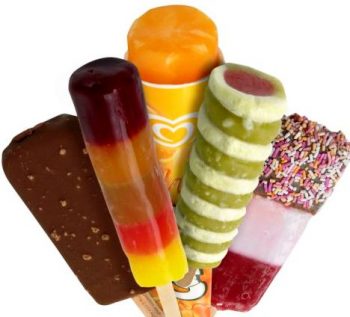Survive a Long, Hot Israeli Summer with Ice Cream Posted by Ayana on Jul 23, 2018 in Uncategorized
The Israeli summer is long. The hot humid season in Israel lasts from June till August, but heat waves hit our little country as soon as the spring. The autumn is pretty warm as well, and so it feels like summer extends for too long. What gives us plenty of opportunities to gorge on ice cream and learn the variety of related Hebrew words.
גְּלׅידָה (ge-li-da) = ice cream
גְּלׅידָה is fairly a new word in the Hebrew language, appearing for the first time in print in 1909. It was revived by Eliezer Ben‑Yehuda (1858–1922) from the archaic Hebrew word גְּלׅיד, meaning “icicle”. Ben-Yehuda chose this word for its meaning, but also because it sounds similar to the Italian word for ice-cream “gelato”. He interwove the ancient word into the already exist pattern םְםׅםםָה, and created a word for the modern sweet frozen food made of whipped cream.
In a nutshell: גְּלׅידָה is a general name for all the sweet frozen desserts appearing in this article. It can be eaten in a cup, in a cone, on a stick or right from the box. It can be dairy, sorbet or vegan.
טִילוֹן (ti-lon) = Cornetto
Ice cream cones were already on the market at the beginning of the 20th century. But companies failed to manufacture palatable cones filled in frozen ice cream that wouldn’t become soggy. In 1959, an Italian ice-cream manufacturer finally produced the Cornetto. An Israeli milk–woman who visited Italy was impressed by the new product. After returning to Israel, her dairy sold the sweet innovation to the Israeli crowd by the name טִילוֹן. The icy dessert became popular in Israel, and many other Cornettoes were sold under different brands and names. But טִילוֹן became a generic trademark for any ready ice cream cone for sale in Israel to this days. The original טִילוֹן is not manufactured anymore.
In a nutshell: when eating in an ice cream parlor (גְּלִידֶרִיָּה), ice cream in a cone will still be called גְּלׅידָה. When buying frozen cone filled with ice cream (in supermarket, kiosk, etc.) it is called טִילוֹן.
שִׁלְגּוֹן (shil-gon) = popsicle, ice–lolly
The Hebrew dictionaries define שִׁלְגּוֹן as a sweet frozen dessert on a stick. It can be creamy (basically an ice cream on a stick), or icy (frozen fruit concentrate on a stick). In the dictionaries this Hebrew word for ice–lolly is punctuated with the vowel “i”. But most of the people pronounce it with the vowel “a” – שַׁלְגּוֹן (shal-gon). I’ve never heard anyone use the correct pronounciation. Fortunately, the Academy of the Hebrew Language accepts both of these pronunciations.
In a nutshell: the Hebrew word for popsicle is שַׁלְגּוֹן. Nowadays, this word is less common among Israelis than the two next terms.
אַרְטִיק (ar-tik) = generic trademark for שִׁלְגּוֹן
In 1952, a couple of Belgian Jews established a creamy popsicles factory in Israel. They called it אַרְטִיק after the English name “Arctic”. Their first popsicle was vanilla ice cream on a stick coated in a fine chocolate shell. The factory created more kinds of popsicles during the 50’s, all under the name אַרְטִיק wrapped in tin wrap decorated with polar bears. Not too long after, a competitor company by the name קַרְטִיב (kar-tiv, a combination of the word קַר meaning “cold” with the word טִיב meaning “quality”) was established. The two companies soon merged to one company called אַרְטׅיק–קַרְטׅיב. Their variety of שַׁלְגוֺנׅים (shal-go-nim, plural form of שִׁלְגּוֹן) was very popular among Israeli kids, but the company was accused of evading taxes, and was closed in 1971. Leaving the Israelis with two generic trademarks – אַרְטִיק and קַרְטִיב – that become even more popular than the authentic Hebrew word for popsicle – שִׁלְגּוֹן. In spoken Hebrew, אַרְטִיק is designated for ice cream popsicle, while קַרְטִיב is designated for ice–lolly (frozen sweet fruit concentrate).
In a nutshell: אַרְטׅיק is the spoken Hebrew word for ice cream on a stick, and קַרְטִיב is the spoken Hebrew word for ice–lolly.
The new גְּלׅידוֺת, טׅילוֺנׅים וְשַׁלְגוֺנׅים for this summer were already revealed last February. Watch this video (and read the attached article) to practice the new vocabulary.
אַתָּה מַעְדׅיף גְּלׅידָה בְּגָבִיעַ אוֺ גְּלׅידָה בְּכּוֹס?
Do you prefer ice cream in a cone or in a cup?
אֲנׅי רוֺצֵה גְּלׅידָה בְּגָבִיעַ.
I want ice cream in a cone.
מַגְנוּם הוּא כַּנִּרְאֶה הָאַרְטִיק הַנִּמְכַּר בְּיוֹתֵר בְּיִּשְׂרָאֵל.
Magnum is probably the most sold popsicle in Israel.
הוּא אוֺהֵב טִילוֹן שׁהַגָּבִיעַ שֶׁלוֺ מְצֻפֶּה בְּשׁוֺקוֺלָד.
He loves Cornetto that its cone coated in chocolate.
אִמָּא קַנְתָּה שַׁלְגוֺנׅים לְכָל הַיְּלָדׅים.
Mum bought popsicle for all the kids.
בְּקַרְטִיב יֵשׁ פָּחוֹת קָלוֺרׅיּוֺת מֵאֲשֶׁר בְּאַרְטִיק.
Ice–lolly has less calories than creamy popsicle.
Related posts:
Beating the Heat in Israel: Ordering Ice Cream in Hebrew
Keep Calm and Learn Hebrew

Build vocabulary, practice pronunciation, and more with Transparent Language Online. Available anytime, anywhere, on any device.






